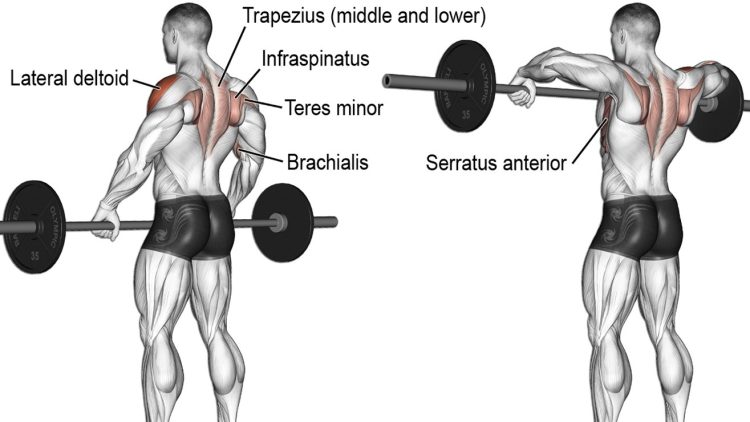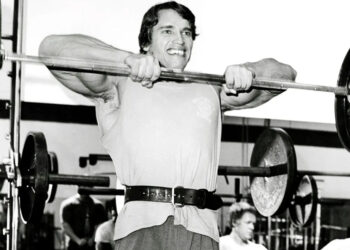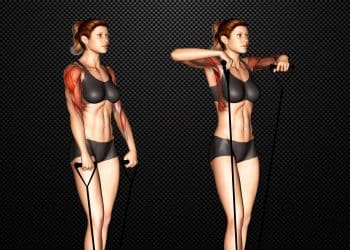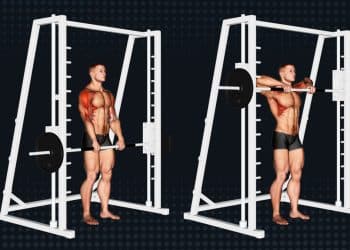The upright row ranks among the most dangerous exercises. Although the barbell upright row might look easy, it is one of the exercises responsible for the most injuries inside the weight room.
If you are like most lifters that are bored of their uninspiring training regimens, the upright row probably has you interested now. Who doesn’t want some thrill in their training regimens, after all?
What is an Upright Row?
The upright row is a compound (multi-joint) exercise that primarily works the shoulders and upper back. The most popular variation of the strength training exercise involves using a barbell. You could, however, also use dumbbells, cables, or kettlebells for this movement.
The upright barbell row involves grabbing the barbell in a hang position and pulling it toward your chin by driving your elbows toward the ceiling while keeping them pointing outward.
The strength training exercise can help build strength and muscle mass. Due to its vertical pulling movement, the upright row can improve your performance in Olympic exercises like the snatch and clean and CrossFit exercises like the high pull.
The upright row is a brilliant movement to build upper body strength, boost muscle mass, improve your performance on the Olympic lifts, correct your posture, and enhance stability and balance. You could perform the upright row in your shoulder, upper body, or pull workout regimen.
Level Up Your Fitness: Join our 💪 strong community in Fitness Volt Newsletter. Get daily inspiration, expert-backed workouts, nutrition tips, the latest in strength sports, and the support you need to reach your goals. Subscribe for free!
Although the upright row is an incredibly effective exercise to build upper body strength and muscle mass, the vertical pulling path of the movement makes you prone to shoulder impingement. You must ensure that you use the correct form to reduce the risk of injury while doing this exercise.
This article covers everything you need to know about the upright row to master the compound lift. You’ll learn about its target muscles, benefits, correct form, and common mistakes. We’ve also included variations and alternatives to add variety to your training regimen.
Muscles Worked During Upright Row
Below are the muscles worked while performing the barbell upright row:
Traps
Bodybuilders include the upright row in their training regimen to build bigger and thicker trapezius muscles. Traps are triangular muscles that start at the base of your neck, go across your shoulders, and extend to the middle of your back.
The upright row targets the top portion of the traps that help elevate and stabilize the shoulders during the movement. You must stay upright throughout the range of motion to target the traps. Using momentum by jerking your legs transfers to the secondary muscle groups.
Deltoids
The upright row engages the middle and front deltoids, which help lift the barbell to your shoulders. Shoulder rotator cuffs play a vital role in doing the upright row. You must spend 5-10 minutes warming your shoulders before doing the upright row to minimize the risk of injury.
The vertical pulling movement recruits the infraspinatus and teres minor, two tiny muscles in the rotator cuff. These muscles help stabilize the shoulder joint and keep the arm in proper alignment while doing the exercise.
Rhomboids
Rhomboids lie under the traps in the upper back. It assists the traps in stabilizing the shoulders and maintaining proper posture during the exercise. You must keep your chest pushed out for optimal rhomboid activation.
Biceps
All pulling movements engage the biceps. Biceps help lift the bar towards your chin. An overwhelming biceps pump during the exercise is a sign you are performing the exercise with an incorrect form. Keep your elbows flared to minimize biceps stimulation.
Forearms
Vertical pulling movements like the upright row require a solid grip, especially with heavier weights, which results in greater forearm engagement. Use a thumbless (thumbs around the bar) grip to reduce your forearm engagement.
Core
You must maintain a straight torso while performing the upright row for optimal muscle stimulation. Keep your core braced throughout the exercise to minimize the use of momentum by swinging back and forth. Wear a weightlifting belt to reduce the stress on your lower back and eliminate the use of momentum.
Benefits of Upright Row
Below are the advantages of adding the upright row to your training regimen:
1. Strength and Muscle Gains
The upright row can help build strength and muscle mass in the upper body. Program the upright row based on your training goals. Use the 1-5 rep range to build strength. Doing 8-12 reps will help induce hypertrophy. [1]
2. Build Bigger Traps
Performing strict upright rows without using momentum by jerking your legs targets your traps. Many bodybuilders use the upright barbell row as a barbell shrug alternative to build bigger traps.
3. Improved Posture
The upright row builds shoulder and upper back strength and muscle, which can improve your posture. This exercise requires you to keep your chest pulled out, which can undo the damage caused by staying hunched over your phone or computer screen for most of your day.
The upright row can improve shoulder stability and reduce injury risk during other functional exercises.
4. Enhanced Core Strength
You must keep your core, lower back, and glutes braced to maintain an upright torso while performing the upright row. The upright barbell row will help strengthen your core, which will carry over to other compound lifts and daily activities.
5. Olympic Technique Practice
Olympic lifts such as the snatch and clean require you to pull the barbell against gravity while keeping it close to your body. The upright row is one of the few exercises that help you train for the mid-range of Olympic movements. You should perform the strict upright row and its variation involving momentum to improve at Olympic lifts.
How To Do an Upright Row
Performing the barbell upright row with an incorrect form can lead to issues like shoulder impingement, rotator cuff tear, and neck pain. So, sit up and take notes on how to perform this exercise with the correct form to minimize the risk of injury and get the best bang for your buck.
Steps
- Stand upright with a shoulder-wide stance.
- Grab a barbell with a shoulder-wide pronated (overhand) grip.
- The barbell should be resting against your upper legs.
- Brace your abs, glutes, and lower back and pull out your chest. This will be your starting position.
- Without using momentum by jerking your legs or swinging back and forth, pull the barbell toward your chin by driving your elbows toward the ceiling.
- Your upper arms should be parallel to the floor, and your elbows in line at the top.
- Keep the barbell as close to your body as possible.
- Pause and contract your traps at the top.
- Slowly return to the starting position.
- Repeat for recommended reps.
Tips
- Start with a light weight and build the resistance gradually to avoid the risk of injury, especially if you perform this exercise at the beginning of your workout.
- Keep your knuckles pointing down throughout the exercise for optimal trapezius recruitment.
- Grabbing the bar with a closer-than-shoulder-width grip will emphasize the shoulders, while a wider grip will focus on your traps.
- Keep your head neutral throughout the exercise and your gaze fixed forward.
- Slow down your negatives for a better shoulder pump.
This Exercise:
- Target Muscle Group: Traps
- Secondary Muscles: Shoulders, Biceps, and Forearms
- Type: Strength
- Mechanics: Compound
- Equipment: Barbell
- Difficulty: Beginner
- Best Rep Range:
- Hypertrophy: 8-12
- Strength: 1-5
Common Mistakes While Performing an Upright Row
Doing the upright row with an incorrect form can make you leave gains on the table and increase the risk of injury. Here are some frequent mistakes that lifters make while performing the upright row:
Going Too Heavy
Since most bodybuilders use the upright row to train their traps, they assume they should use similar weights on this exercise as the barbell shrugs. There is a big difference in the range of motion of both exercises. Using more weights than you can control on the upright row multiplies your odds of injury.
Using Momentum
The use of momentum is most common in lifters with more weights on the bar than they can handle. If you are training for hypertrophy, you should limit the movement to your arms and shoulders. Using your legs to lift the weight can remove tension from your shoulders and put it on secondary muscles.
Level Up Your Fitness: Join our 💪 strong community in Fitness Volt Newsletter. Get daily inspiration, expert-backed workouts, nutrition tips, the latest in strength sports, and the support you need to reach your goals. Subscribe for free!
On the flip side, if you are a weightlifter or CrossFitter doing the upright row as an accessory lift, you can use your legs to lift the weight.
Swinging Your Torso Back and Forth
Although using momentum by jerking your legs is acceptable in the case of weightlifters and CrossFitters, swinging your upper body like a pendulum is forbidden while doing the upright row. Keep your torso upright, core braced, and chest pulled out throughout the exercise.
Pulling Your Elbows Above Shoulder Height
Raising your elbows above shoulder height can put unnecessary strain on your neck, deltoids, and shoulder rotator cuffs, putting you at a greater risk of muscle or nerve impingement. You should pause the concentric (upward) movement when your upper arms are parallel to the floor.
Not Engaging Your Core
If you find yourself swinging your torso back and forth while performing this exercise, it is likely because you are not bracing your core, lower back, and glutes.
Keeping Your Elbows Close To Your Body
Since the upright row requires you to keep the bar close to your body, most lifters pull their elbows close to their sides. Keeping your elbows close to your body will result in greater biceps stimulation and can cause shoulder impingement at the top.
Shrugging Your Shoulders
Many lifters use a shrugging motion to lift the bar toward their chin. Doing this will put you at a greater risk of neck and shoulder impingement. You must lift the bar using your elbows while keeping your shoulders pulled back and down.
Using a Weird Angle
Some lifters keep the bar close to their body during the concentric (upward) motion but push it out during the eccentric (downward) motion in hopes of achieving a greater trap engagement. This weird rowing movement puts you at a greater risk of shoulder, neck, and trapezius injury.
Variations and Alternatives of Upright Row
Spice up your upper body workouts with these upright row alternatives and variations:
Dumbbell Upright Row
You’ll follow the same technique in this exercise as the barbell upright row, with the only difference being that you’ll swap the bar with dumbbells.
Steps:
- Hold the dumbbells with an overhand (pronated) grip at shoulder width.
- Place the dumbbells against your quads at the starting position.
- While keeping the dumbbells as close to your body as possible, pull them to your chest until your upper arms are parallel to the floor.
- Pause and contract your traps at the top.
- Slowly return to the starting position.
- Repeat for recommended reps.
Pro Tip: Use one dumbbell at a time to fix muscle and strength imbalances. Ensure that you maintain a square chest and shoulders while performing this variation.
Check out our complete dumbbell upright row guide here!
Cable Upright Row
Using a cable adds variety and delivers a different stimulus than free weights.
Steps:
- Set the pulley at the lowest setting and attach a straight bar.
- Grab the bar with a pronated grip and take a step back. The cable should be taut at the starting position.
- Brace your core and pull the handle to your chin by driving your elbows high.
- Pause and contract your shoulders at the top.
- Slowly return to the start position.
- Repeat for recommended reps.
Pro Tip: Using a cambered bar can help alleviate stress from your wrists and improve your range of motion.
Check out our complete cable upright row guide here!
Snatch-Grip Upright Row
The snatch-grip upright row is a great exercise for Olympic lifters as it can improve your upright vertical pulling performance.
Steps:
- Use a snatch grip on the barbell.
- The barbell should rest between your hip crease at the starting position.
- While keeping your feet planted, explosively pull the bar to your chin by driving your elbows high.
- Reverse the movement.
- Repeat for recommended reps.
Pro Tip: Don’t shy away from using momentum while performing this lift. The objective here is to build explosive strength.
Snatch Pull
The snatch pull is a full-body exercise. This exercise reduces the snatch’s range of motion to half.
Steps:
- Take a shoulder-wide stance in front of a barbell placed on the floor.
- Squat down and grab the bar with a snatch grip.
- Perform a snatch deadlift to get the bar off the floor.
- Keep the bar as close to the body as possible.
- Pull the bar to the bottom of your rib cage.
- Return to the start.
- Repeat for reps.
Pro Tip: Drop the bar after completing a rep. Your focus should be on performing upright rows. Avoid spending energy on lowering the bar to the floor.
Barbell Shrug
The barbell shrug is a staple in most shoulder workouts. It is one of the best exercises to build the trapezius muscle.
Steps:
- Stand upright with a shoulder-wide stance.
- Grab the bar with a shoulder-wide overhand grip.
- While maintaining a slight bend in your elbows, lift your shoulders to your ears.
- Pause and contract your traps at the top.
- Slowly return to the start.
- Repeat for reps.
Pro Tip: Keep an upright torso and your head neutral throughout the exercise. Bending your neck forward can put it under unnecessary strain.
Check out our complete barbell shrug guide here!
Barbell Row
The barbell row primarily works the lats and helps build back thickness.
Steps:
- Stand upright with a shoulder-wide stance.
- Grab a barbell with a shoulder-wide overhand grip.
- Bend your knees slightly and push your hips back. Bend forward so that your torso is almost parallel to the floor.
- Brace your core and pull the bar to your belly button.
- Pause and contract your lats at the top.
- Slowly return to the starting position.
- Repeat for reps.
Pro Tip: Perform this exercise while maintaining your torso at a 70-degree angle with the floor. It will help put more focus on your traps.
Check out our complete barbell row guide here!
FAQs
Should my heels remain on the floor throughout the upright row?
Yes, especially if you are a bodybuilder training for hypertrophy. Weightlifters can raise their heels off the floor as their goal is to lift as heavy as possible.
How to reduce forearm stimulation while performing the upright row?
Using a thumbless grip can reduce forearm engagement while doing the upright row. Furthermore, you could use lifting straps to eliminate your forearm and grip strength from the movement.
Why do I feel shoulder pain while doing the upright row?
If you are experiencing shoulder pain at the top of the movement, it might be because you are going too high. Limit your range of motion to the point where your upper arms are parallel to the floor.
Wrapping Up
The upright row can help build a bigger and stronger upper back and shoulders. It is, however, one of the most incorrectly done exercises, which should be evident by the high number of form mistakes listed in this article. This article details the correct upright row technique to get the most benefit and limit your risk of injury.
Use the upright row alternatives and variations to improve the range of your shoulder, upper body, or pulling workout regimen. Best of luck!
References
- Krzysztofik M, Wilk M, Wojdała G, Gołaś A. Maximizing Muscle Hypertrophy: A Systematic Review of Advanced Resistance Training Techniques and Methods. Int J Environ Res Public Health. 2019 Dec 4;16(24):4897. doi: 10.3390/ijerph16244897. PMID: 31817252; PMCID: PMC6950543.









